Related Research Articles
The History of Slovakia, dates back to the findings of ancient human artifacts. This article shows the history of the country from prehistory to the present day.
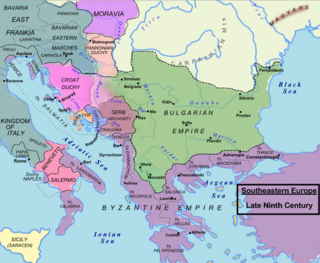
The Principality of Serbia was one of the early medieval states of the Serbs, located in the western regions of Southeastern Europe. It existed from the 8th century up to c. 969–971 and was ruled by the Vlastimirović dynasty. Its first ruler known by name was Višeslav who started ruling around 780. While by that time, starting from the year 680–681, the Bulgarian state had taken the lands to the east. Vlastimir resisted and defeated the Bulgarian army in a three-year-war (839–842), and the two powers lived in peace for some decades. Vlastimir's three sons succeeded in ruling Serbia together, although not for long; Serbia became a key part in the power struggle between the Byzantines and Bulgarians, predominantly allied with the Byzantines, which also resulted in major dynastic wars for a period of three decades. The principality was annexed in 924 by Simeon I and subjected to Bulgarian rule until 927 when Serbian prince Časlav was established as ruler of the Serbian land, and united several Serbian regions, becoming the most powerful ruler of the Vlastimirović dynasty.

Great Moravia, or simply Moravia, was the first major state that was predominantly West Slavic to emerge in the area of Central Europe, possibly including territories which are today part of the Czech Republic, Slovakia, Hungary, Austria, Germany, Poland, Romania, [Croatia], Serbia and Ukraine. The only formation preceding it in these territories was Samo's tribal union known from between 631 and 658 AD.
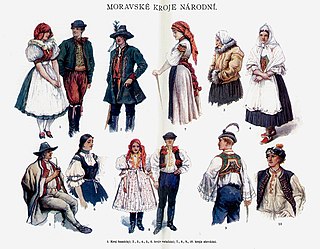
Moravians are a West Slavic ethnographic group from the Moravia region of the Czech Republic, who speak the Moravian dialects of Czech or Common Czech or a mixed form of both. Along with the Silesians of the Czech Republic, a part of the population to identify ethnically as Moravian has registered in Czech censuses since 1991. The figure has fluctuated and in the 2011 census, 6.01% of the Czech population declared Moravian as their ethnicity. Smaller pockets of people declaring Moravian ethnicity are also native to neighboring Slovakia.

The Great Morava is the final section of the Morava, a major river system in Serbia.
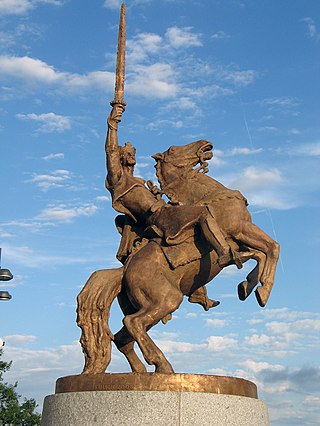
Svatopluk I or Svätopluk I, also known as Svatopluk the Great, was a ruler of Great Moravia, which attained its maximum territorial expansion during his reign.

Glad was the ruler of Banat at the time of the Hungarian conquest of the Carpathian Basin around 900 AD, according to the Gesta Hungarorum. The Gesta, which was written by an author known in modern scholarship as Anonymus in the second half of the 12th century or in the early 13th century, is the earliest extant Hungarian chronicle. The Gesta did not refer to the enemies of the conquering Hungarians, who had been mentioned in earlier annals and chronicles, but wrote of a dozen persons, including Glad, who are unknown from other primary sources of the Hungarian Conquest. Therefore, modern historians debate whether Glad was an actual enemy of the conquerors or only a "fictitious person" made up by Anonymus. In Romanian historiography, based on the mention by Anonymus some 300 years later, Glad is described as one of the three Romanian dukes who ruled a historical region of present-day Romania in the early 10th century.
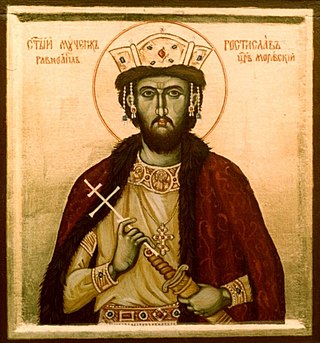
Rastislav or Rostislav, also known as St. Rastislav, was the second known ruler of Moravia (846–870). Although he started his reign as vassal to Louis the German, king of East Francia, he consolidated his rule to the extent that after 855 he was able to repel a series of Frankish attacks. Upon his initiative, brothers Cyril and Methodius, sent by the Byzantine Emperor Michael III in 863, translated the most important Christian liturgical books into Slavonic. Rastislav was dethroned by his nephew Svatopluk I of Moravia, who handed him over to the Franks. He was canonized by the Eastern Orthodox Church in 1994.

Mojmir I, Moimir I or Moymir I was the first known ruler of the Moravian Slavs (820s/830s–846) and eponym of the House of Mojmir. In modern scholarship, the creation of the early medieval state known as Great Moravia is attributed either to his or to his successors' expansionist policy. He was deposed in 846 by Louis the German, king of East Francia.
Pribina was a Slavic prince whose adventurous career, recorded in the Conversion of the Bavarians and the Carantanians, illustrates the political volatility of the Franco–Slavic frontiers of his time. Pribina was the first ruler of Slavic origin to build a Christian church on Slavic territory in Nitra, and also the first to accept baptism.

The Principality of Nitra, also known as the Duchy of Nitra, was a West Slavic polity encompassing a group of settlements that developed in the 9th century around Nitra in present-day Slovakia. Its history remains uncertain because of a lack of contemporary sources. The territory's status is subject to scholarly debate; some modern historians describe it as an independent polity that was annexed either around 833 or 870 by the Principality of Moravia, while others say that it was under influence of the neighbouring West Slavs from Moravia from its inception.
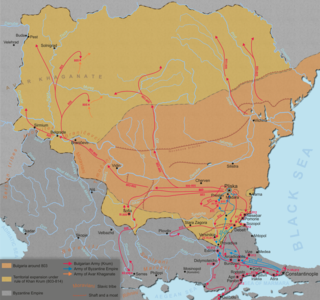
The Timočani were a medieval South Slavic tribe that lived in the territory of present-day eastern Serbia, west of the Timok River, as well as in the regions of Banat, Syrmia and Moesia Superior.

Kocelj was a ruler of the Slavs in Lower Pannonia. He was an East Frankish vassal titled comes (count), and is believed to have ruled between 861 or 864 and 876.

The Hungarian conquest of the Carpathian Basin, also known as the Hungarian conquest or the Hungarian land-taking, was a series of historical events ending with the settlement of the Hungarians in Central Europe in the late 9th and early 10th century. Before the arrival of the Hungarians, three early medieval powers, the First Bulgarian Empire, East Francia, and Moravia, had fought each other for control of the Carpathian Basin. They occasionally hired Hungarian horsemen as soldiers. Therefore, the Hungarians who dwelt on the Pontic steppes east of the Carpathian Mountains were familiar with their future homeland when their conquest started. Archaeogenetic studies confirmed the Asian origin of the conquerors.

The Christianization of Moravia refers to the spread of the Christian religion in the lands of medieval Moravia.

The Moravians were a West Slavic tribe in the Early Middle Ages. Although it is not known exactly when the Moravian tribe was founded, Czech historian Dušan Třeštík claimed that the tribe was formed between the turn of the 6th century to the 7th century, around the same time as the other Slavic tribes. In the 9th century Moravians settled mainly around the historic region of Moravia and Western Slovakia, but also in parts of Lower Austria and Upper Hungary.

The Archbishopric of Moravia was an ecclesiastical province, established by the Holy See to promote Christian missions among the Slavic peoples. Its first archbishop, the Byzantine Methodius, persuaded Pope John VIII to sanction the use of Old Church Slavonic in liturgy. Methodius had been consecrated archbishop of Pannonia by Pope Adrian II at the request of Koceľ, the Slavic ruler of Pannonia in East Francia in 870.
Alternative theories of the location of Great Moravia propose that the core territory of "Great Moravia", a 9th-century Slavic polity, was not located in the region of the northern Morava River. Moravia emerged after the fall of the Avar Khaganate in the early 9th century. It flourished during the reign of Svatopluk I in the second half of the century, but collapsed in the first decade of the 10th century. "Great Moravia" was regarded as an archetype of Czechoslovakia, the common state of the Czechs and Slovaks, in the 20th century, and its legacy is mentioned in the preamble to the Constitution of Slovakia.
Praedenecenti was an early medieval Slavic tribe, mentioned only in the Royal Frankish Annals in 822 and 824. They lived in the buffer zone between the Carolingian and Bulgarian empires. The Royal Frankish Annals associated them with the Abodriti, while modern scholars have also connected them to other Slavic tribes, especially the Braničevci or Merehani. The Praedenecenti sought assistance from the Franks against the Bulgars, but they obviously lost their independence because they were not mentioned after 824.
References
- ↑ Barford 2001, p. 109.
- 1 2 3 Bowlus 1994, p. 11.
- ↑ Goldberg 2006, pp. 135–136.
- ↑ Havlík 2013, p. 109.
- ↑ Steinhübel 2011, p. 54.
- ↑ Třeštík 2010, pp. 132–35.
- ↑ Vlasto 1970, p. 20.
- ↑ Püspöki-Nagy 1978, p. 15.
- ↑ Senga 1983, pp. 318.
- ↑ Komatina 2010, p. 21.
- ↑ Komatina 2010, p. 22.